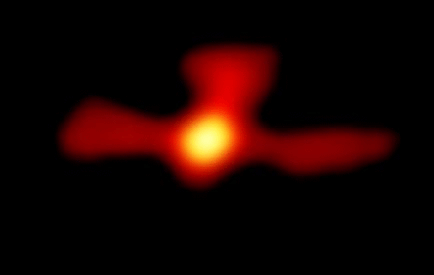
In this lecture we will look at anti-matter in astrophysics.
The Big Bang model of the universe's beginning includes a small difference between the amount of matter and anti-matter which was created: there are 30 billion and one matter particles for every 30 billion anti-particles. The annihilation of anti-matter and matter releases energy and the small anti-symmetry is in fact just the matter we see around us afterwards. The difference is based on a small, observed asymmetry in the laws of physics known as CP violation. Although in the standard theory all the anti-matter is destroyed, it may be that if the Big Bang was not homogeneous, regions of matter and anti-matter could have been created. This leads to the possibility of the existance of anti-galaxies, anti-stars and even anti-life-forms! A clear difficulty with this idea is that when matter and anti-matter meet they annihilate and would produce energy in the form of gamma rays - such gamma rays have been searched for and are not believed to exist. The way to prevent this is to keep the matter and anti-matter regions well separated, but we know from recent studies that galaxies are in fact spread rather homogeneously through space in a foam like structure, so keeping anti-matter and matter apart seems to present problems.
Is the existance of anti-galaxies or anti-stars nevertheless a serious possibility? One way to find out is to go and look for anti-particles amongst the huge cosmic ray flux hitting the Earth. Experiments in this direction began in the 1960s, and involved sending particle detectors high into the atmosphere, above 99% of the air, and examining every cosmic ray hit to determine if any were from anti-matter. So far, the only particles which have been found are positrons and anti-protons - no anti-particle heavier than this has yet been found. If such a particle were found, it would be revolutionary, because as far as is known there is no way to produce such particles except as debris from the Big Bang.
If there exist anti-galaxies, they would appear in emitted radiation just like normal galaxies (assuming that the emission properties of anti-matter are indeed exactly like matter, although this is about to be actually tested in the laboratory). Only anti-particles travelling across inter-galactic space would then reveal such galaxies. This imposes a rather difficult problem, because intergalactic space is expected to carry very weak magnetic fields. Since the particles are charged, they would be deflected by the fields and there might be limits on how far they can travel from their parent anti-galaxies. No good estimates of what this might be exist, because the structure and strength of the inter-Galactic magnetic field is completely uncertain. For this reason it is worth looking anyway.
From 2002 the Alpha Magnetic Spectrometer will fly for three years on the International Space Station. It will be the first magnetic spectrometer in space, and will be able to sort particles and anti-particles with very high accuracy. High accuracy is needed because there are huge numbers of particles expected for each anti-particle, and so even a small error in the particle classification would create a false signal in the data. AMS will have about 100 times the sensitivity of all previous experiments.
Another exciting aspect of the experiment is that it might lead to the detection of a signal due to the dark matter. One leading candidate for the dark matter are a class of particles called WIMPS, or ``weakly interacting massive particles''. WIMPS can be the dark matter almost by definition, since they are ``weakly interacting'' (with normal matter) they are difficult to detect, and they are also heavy (much heavier than protons for example). What there mass or mass spectrum would be is then unknown, but whatever it is, the decay of the particles or their annihilation could produce gamma rays, or particle pairs at a characteristic energy, which could be detected by a sensitve cosmic ray experiment. Recently, the High Energy Anti-Matter Telescope (HEAT), flown on a high altitude balloon, detected a slight difference between the expected energy spectrum of cosmic ray positrons and the observations. This difference might be explained as another possible source of anti-matter - WIMPS. More detailed studies are needed, and this is one of the projects AMS is designed to carry out.
Closer to home, a definite anti-matter source has been found at the center of our own Galaxy. The source reveals itself as a line of gamma-ray emission caused by electrons and positrons annihilating. The positrons appear to be generated by high energy particle or gamma ray decay. The center of the Galaxy is rich in high energy sources which could provide the high energies needed to do this, including the jets of micro-quasars or X-ray binaries, supernova remnants, star burst regions (in which very high rates of star formation are occuring) and the central black hole itself.
|
Problem 10.1 At what energy would you expect the decay line to have been seen? Find out more about this source and write it as a one page report.
|
